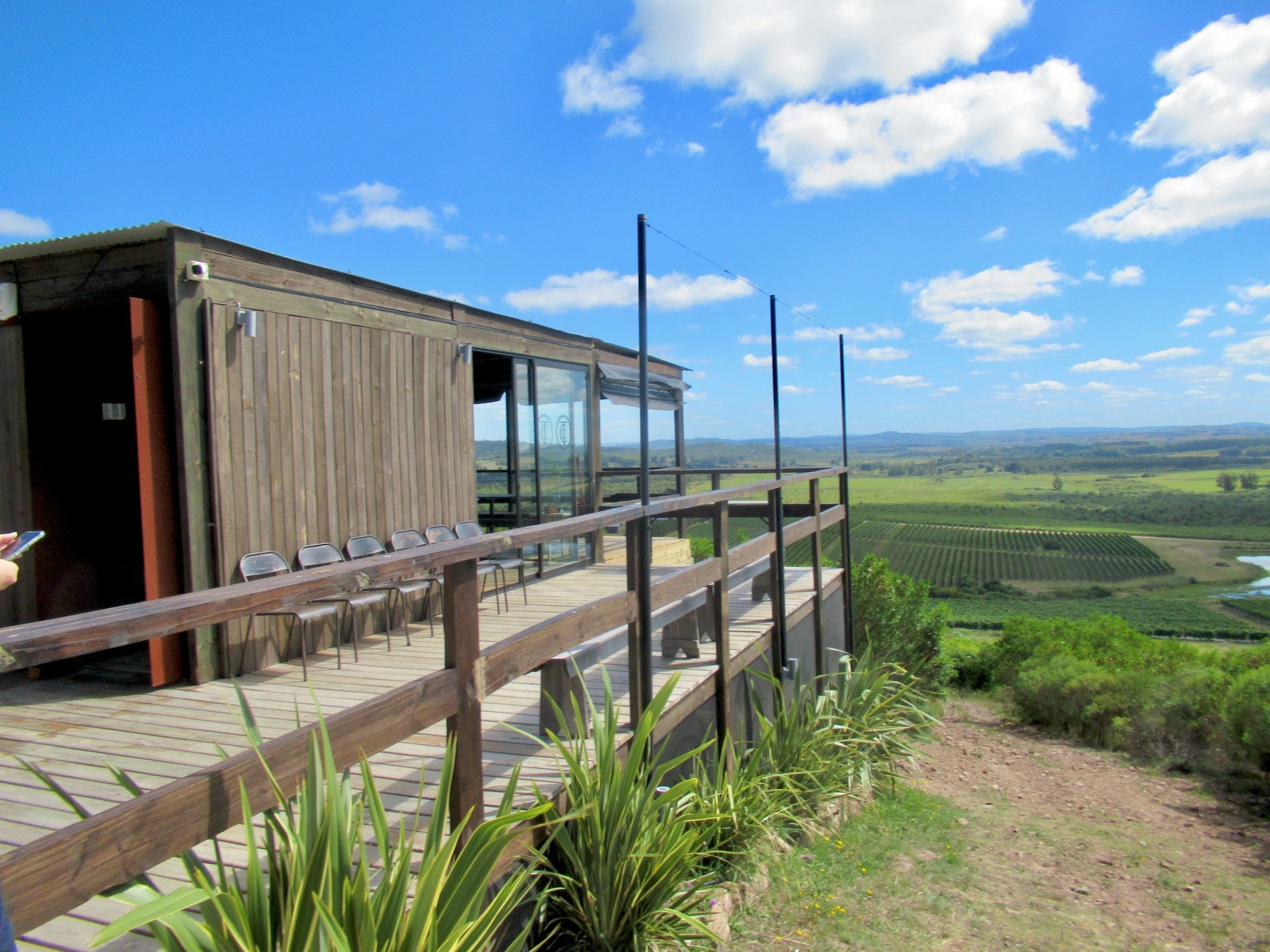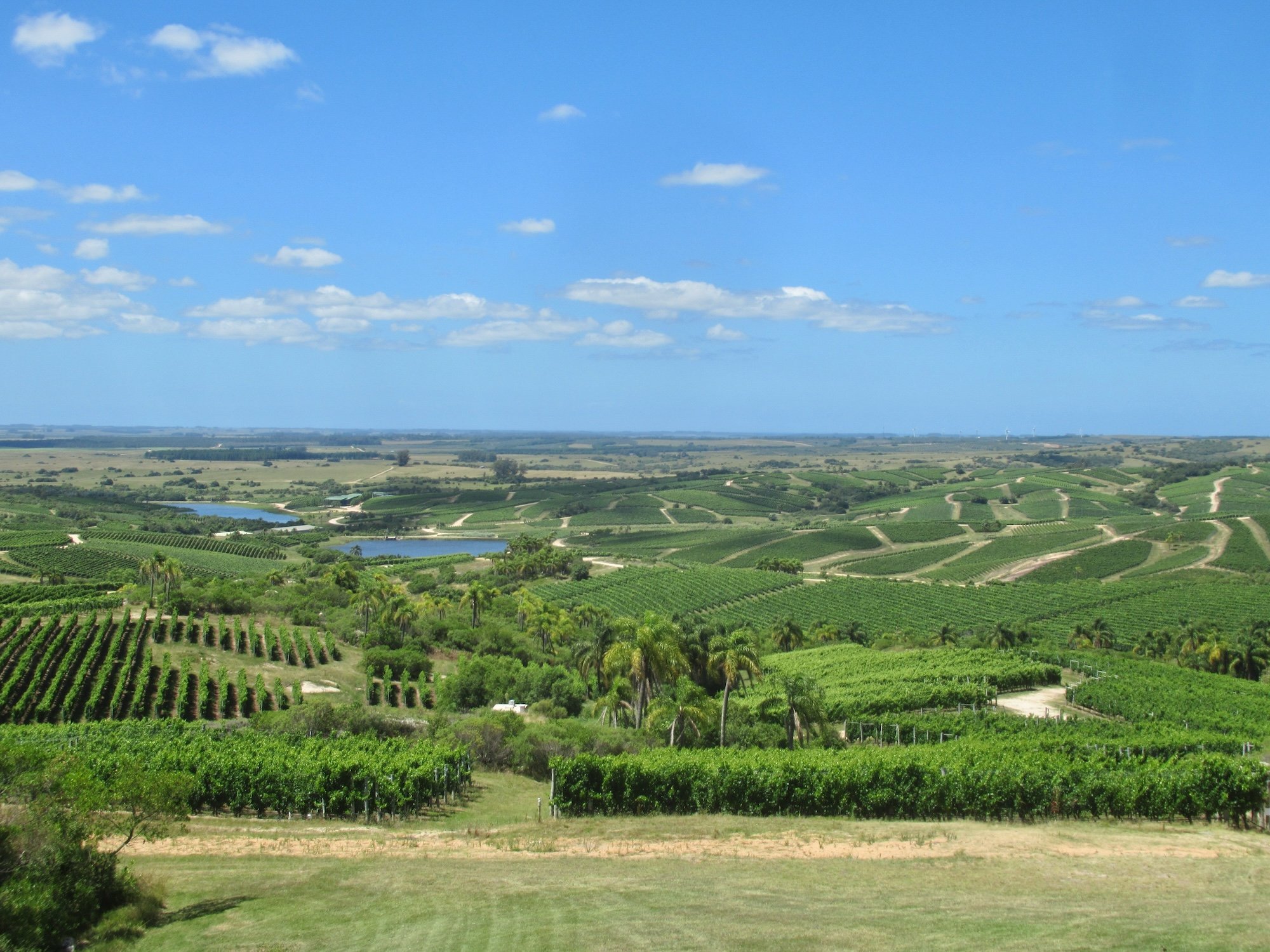Not Tannat, Dear, I Have an Albariño
Uruguay’s ‘national red’ may soon be joined by a ‘national white’
Cerro del Toro Tasting Room and Vineyards
The scene: A wine-tasting session on a slopeside deck overlooking the vineyards, distant green hills, and valley-floor reservoir of Bodega Cerro del Toro, 20 miles west of Uruguay’s fun-city getaway, Punta del Este.
The players: Martín López, every inch the laid-back winery General Manager, with well-trimmed beard, shades, and jaunty straw hat. His sidekick and Winemaker at Cerro del Toro, Martín Viggiano, wearing an Albariño 2022 T-shirt with some Portuguese words that, according to Google Translate, we can’t print in a family alcohol magazine. Three wine journalists who actually know what they’re talking about. And your faithful correspondent.
Cerro del Toro 2022 Albariño Sobre Lías
The wine: A 2022 single-vineyard Albariño Sobre Lías, whose grapes were grown within two miles of the Atlantic, hand-harvested, aged with the lees in stainless steel for nine months, then stabilized, filtered, and bottled as part of Cerro del Toro’s offbeat Unique Editions line.
Albariño is a white wine similar in taste to sauvignon blanc, but less herbal, very dry, and usually with high acidity. Everyone at our table agrees that this albariño has good minerality, with a pleasant tang and notes of peach and apricot. Yet because of the aging on the lees, it’s somehow, well, different from your average albariño. Hard to put your finger on it. Or your mouth.
The point is that, in Uruguay’s wine scene, albariño is everywhere, to the degree that winemakers have to experiment to make their versions stand out. “You can have so many styles of albariño just based on the moment you harvest,” says Santiago Deicas, winemaker of Familia Deicas in Canelones, near Montevideo. “We’re still researching.”
Single-vineyard albariños. Oak-aged versus stainless albariños. Ocean-influenced albariños. Pét-nat albariños. Blended albariños. It’s almost as if, as if… (wait for it)…
“If you didn’t already figure it out,” says López of Cerro del Toro, “Uruguay has albariño fever.”
The National White Grape?
Daniel Pisano, PIsano Winery, in the ancient kitchen and tasting room
Near the village of Progreso, 20 miles north of Montevideo, I meet Daniel Pisano, Sales Director of Pisano Wines. He turns out to be a wonderful Uruguayan character, complete with handlebar mustache and a carefree, sometimes comedic attitude. But he knows the wine business. He runs the winery with his two brothers, Eduardo and Gustavo, grandsons of the winery’s Italian-born founder, Césare Pietro Secundino Pisano. This year marks Pisano Wines’ 100th anniversary.
Pisano RPF Albariño
We’re seated in an old kitchen with a deep hellhole of an oven whose decades of open-flame cooking have charcoaled the outer stone walls black. Overhead, balanced on exposed wooden beams under a high ceiling, scores of empty wine bottles threaten to topple down on us every time someone enters the room. The atmosphere is informal, low-lit, medieval. At a long, well-scarred table, we sample some wine, beginning with Pisano’s 2023 RPF Albariño, its first ever. (The conceit of the RPF label is that the family reserves the wine for their own enjoyment—but they “happen” to make enough extra for retail.)
“In Uruguay now,” says Daniel Pisano, “you must have an albariño. The opinion-formers said, ‘Albariño has found a home in Uruguay.’ This was about 8 or 10 years ago. They said it would be the ‘national white grape.’ Now people outside the country want albariño from Uruguay. Who wants another sauvignon blanc? No, it must be albariño.”
The wine is big, fresh, aromatic. I ask Pisano where he gets his pre-release opinions.
“My wife,” he says with a shrug. “She’s my focus group.”
The Long Road from Galicia to Uruguay
The proximity of the ocean to Cerro del Toro's albariño vineyards lend a note of salinity to the wines
No one will deny that tannat is the pre-eminent grape in Uruguay. Albariño doesn’t come close. Robust and tannic (as its name implies), tannat is a wine to drink with red meat, not to sip by the pool. Tannat has been the wine grape in Uruguay almost since growers introduced it in 1870. Not until the recent rise in albariño, over the past 20 years, has any single grape garnered equal attention.
It's not easy to get noticed when your wine-growing neighbors include Chile and Argentina. Uruguay produces roughly 4% of South America's wines. It ships only about 40,000 cases of wine per year to the United States, barely enough for your average dot-com Christmas party, let alone its own section in the nation’s wine shops. But the recent rise in Uruguay’s albariños may be the ticket to give the nation’s winemakers wider recognition in the U.S.
Current thinking in enology is that albariño is native to the Spanish autonomous region of Galicia, at the northwestern corner of Iberia. It wasn’t until 2000 that someone recognized the similarities between Galicia’s terroir and that of coastal Uruguay.
“The view, the rain, the influence of the ocean, the wind—it resembles Galicia’s climate,” says López of Cerro del Toro.
The question remains, though, how the albariño vines found their way to Uruguay. Spain has strict laws about the export of grape vines. Was the source a midnight foray into a Galician vineyard, a cut and a snip, and then a few concealed vines whisked through Customs in a nondescript suitcase? More than one person suggested that scenario during my recent visit to Uruguay.
One thing that no one disputes, though, is that Bodega Bouza in Melilla, just outside Montevideo, was the first modern-day winery to plant albariño in Uruguay, in 2001. Agustin Bouza, winery manager, laughs off the salacious rumors of intrigue at midnight in the fields of Spain.
“We just followed normal procedures,” says Agustin, with a smile.
Bodega Bouza Albarino 2023
At a tasting during my recent visit, I try the family’s robust tannat and its oak-barrel-aged chardonnay. The star of the table, though, is the 2023 Albariño, which is well-balanced, dry and acidic, fresh and aromatic. Fermentation was in stainless steel (90%) and French oak (10%). Its light straw color is attractive in the glass. But is it better than anyone else’s? Since all the albariño in Uruguay appears to stem from the same original import, the chances of similarities are great. The soil, proximity to the sea, elevation of the vineyards, and the winemaker’s art are what make the difference between one winery’s albariño and another’s.
To import the cuttings 24 years ago, the family had to apply to a French vineyard to serve as a conduit to buy and export the vines from Galicia to France. From there, they were able to export them to Uruguay. The vines were then propagated in a nursery until ready for planting. They had their initial release in 2004.
“We were the first in South America to grow albariño,” says Agustin, “and maybe the first in the Southern Hemisphere, but we’re not sure.”
The question lingers, though, how other wineries in Uruguay got their albariño vines, a topic that is still a matter of affable late-night speculation.
The World Is Demanding Uruguayan Albariño
Bodega Garzon's extensive vineyards in Maldonado
Unlike tannat, albariño might be described as an “easy-drinking” wine. Irrespective of its technical merits, it’s bright, refreshing, dry, and fruity, almost exactly the international trend in wine retail. White wines with lower alcohol (Uruguayan albariños are often between 11.5% and 12.5% or less) are on the ascent.
One winery that is banking on the trend is Bodega Garzón in Maldonado. Among the largest and sleekest wineries in the country, Garzón grows albariño on one-fifth of its 220 hectares (544 acres) of vineyards.
“We are the largest producer of albariño sold in all the Americas,” says Nicolas Bonino, Garzon’s Marketing Director. “Now we are selling more albariño than tannat in the U.S. The future for us is the U.S.”
After Brazil, Europe, and domestic sales, the United States is a key market for Uruguayan wines. Because of competition from spiked teas, low-alcohol lemonades, and other summery beverages, the wine industry faces an existential challenge. Now may be the time for Uruguay’s albariños to find their rightful place in the market.







